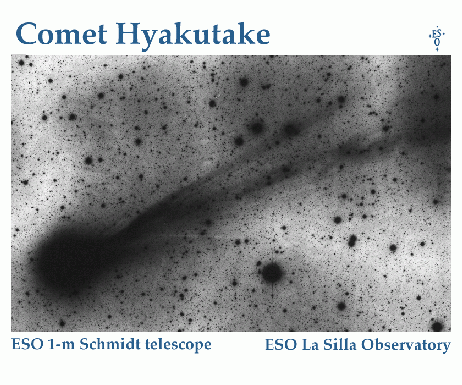 |
Астронет: Астрономическая картинка дня К нам летит комета Хиякутаке http://www.variable-stars.ru/db/msg/1161817/eng |
Credit & Copyright: Oscar Pizarro, 1-meter Schmidt Telescope, La Silla, Chile,
European Southern Observatory
Explanation:
The reaction of ancient peoples to the appearance
of bright comets has toppled
empires, de-throned kings, and been taken as a sign of great things to
come. Probably some of these comets did not get as bright as
Comet Hyakutake
("hyah-koo-tah-kay") will in the next two weeks. It is likely that every
major news organization will soon cover
Comet Hyakutake
extensively.
Comet
Hyakutake is
shown above
already showing a tail of
dust.
This image, taken directly from a photographic negative, shows
stars as black spots and the
bright comet coma and tail as dark clouds
against the white background of space.
During
its
closest approach to the Earth on March 25th,
Comet
Hyakutake will appear in
the Northern hemisphere as a diffuse ball of light brighter than most
stars.
Comet
Hyakutake
will be
visible
then most of the night even without
binoculars,
passing
above the stars in the handle of the Big Dipper.
Comet
Hyakutake will be best seen in dark skies far from city lights, where
its tail - possibly extending 20 degrees or more - will be most easily
visible. As
Comet Hyakutake
recedes from the Earth
it will fade, but
brighten again as it nears the sun later in April. At that time
it
will be best seen in the southern hemisphere. There is no chance Comet
Hyakutake will hit the Earth.
Information:
The
Scale of the Universe Debate in April 1996
Authors & editors:
Robert Nemiroff
(MTU) &
Jerry Bonnell
(USRA)
NASA Web Site Statements, Warnings,
and Disclaimers
NASA Official: Jay Norris.
Specific
rights apply.
A service of:
LHEA at
NASA /
GSFC
& Michigan Tech. U.
